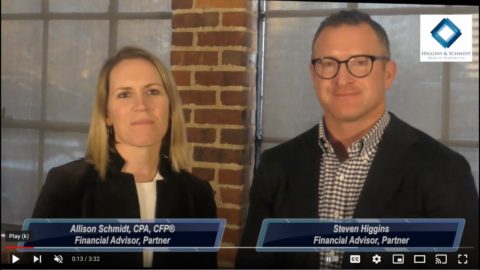
What Have You Learned?
Becoming a better investor and why you are not John Denver
By Steven Higgins, Financial Advisor, Principal
Nothing brings out emotions like the stock market. Over longer periods of time, the U.S. stock markets (specifically the S&P 500 or the DOW, two widely held indexes of the largest companies in America) are some of the most predictable investments over the long term you can find. Nevertheless, every time volatility so much as whispers, investors from the novice to the seasoned can react emotionally and irrationally. What I’ve found over the last fifteen years is that it isn’t just the presence of volatility that upsets people, it’s whether they notice it. For example, if the media gets excited about it, so does everybody else. If the media ignores it, so does everybody else. If the volatility coincides with a statement cycle, meaning an investor sees the month over month change in their mailbox, it makes a difference. In contrary, if a bout of volatility comes and goes between statements, it is often ignored. Probably, the most comical example of this is what we like to call the “vacation panic.” “Vacation panic” sets in when an otherwise busy person takes a week or two off of work and has the time to watch the news or peruse their various “news” apps while drinking margaritas by the pool. All of a sudden, the investor on sabbatical is exposed all types of economic fodder. We aren’t too shocked when we get a nervous email with concerns about what the impact of a default in Greek municipal debt will have have on the currency markets, trade policy, and of course their own retirement plans. You can imagine what happens when an investor goes on permanent vacation (also called retirement). Essentially, people tend to think that volatility was invented just when they started to watch. That logic is akin to thinking that trees falling in the forest only make noise when somebody is listening. Stock market corrections happen regularly whether you are paying attention or not. 
Since 1998, there have been ten true technical corrections in the S&P 500. A correction is when the index drops by at least 10% from its high. Two of those corrections reached (50%) with the average being (22.33%). The current correction low was 10.2%. On average, it has taken the S&P 500 212 days to recover from a correction. Currently we are over half recovered from this correction and it’s been 41 days. If you had terrible timing and only invested the day each one of those corrections started you would have an average annual return of 14.90% (S&P 500 w/dividends reinvested.)* The common thought is that it has been nothing but smooth sailing and up markets since the depth of the Great Recession. The truth is, there have been just as many corrections in the five years after 2008/09 as there were in the five years before.

Recently, at an investor workshop I asked the attendees, all retirement aged investors, “What percentage of stock market corrections have we recovered from in the past?” I got all kinds of answers from the group. Surprisingly, not one person gave the correct answer which was 100% (current correction not included since we are still in the midst of it). I do, however, like our chances. It seems as though we as Americans have been made into pessimists. It could be the the onslaught of media constantly telling us how bad things are and how “this time is different” I believe there are two elements contributing to this irrational paranoia.
- Some believe you can have the good without the bad. In a sense there is misinformation propagated by day traders and annuity salespeople that makes you believe you can have the the positive returns of the stock market without the volatility. Wrong. If somebody had figured out how to capture the gains of the market in the absence of any risk, they would rule the world instead of sitting at your kitchen table squeezing commission dollars out of you and going on incentive sales trips.
- There is a severe lack of knowledge and education about investing and markets. In the absence of knowledge, emotions pervade decisions. For some reason, we tend to display our intellectual wherewithal in the form of market and economic jargon. Gents, I’m mostly talking to you. Let’s be real, you get a group of guys together and they all pretend to be experts in one of four areas: money, politics, sports, or cars. Since you can’t cause too much damage trying to change your own oil, guess where you can do the most damage? Your money it is. Reading the Wall Street Journal and the monthly newsletter you subscribed to doesn’t make you a qualified financial advisor any more than knowing the words to Thank God I’m a Country Boy makes you John Denver. To sum this up, a great deal of the investing public has fear bordering on paranoia masked by illegitimate arrogance when it comes to investing. When every correction comes along, albeit as often as even numbered years, many can’t help but make knee-jerk changes to their 401(k) in the hopes that maybe they can time the market correctly just this once.
Every correction in the S&P 500 has recovered. The chart above tells you that investors have done very well even investing before corrections. So, if history tells you that corrections have never hurt anybody, then it can only be what investors do during the corrections that hurt them. We make certain that we talk about emotions, volatility, and investing with our clients. We probably talk about emotional reactions more than most advisors. We also take great care to understand how much volatility a client can truly handle so that we can develop a portfolio and give them the best chance to stay invested through every market cycle.
Sure, there may be folks out there selling a product or scheme on the basis that you can have your cake and eat it too. They are lying and capitalizing on an irrational fear. Remember, the question, “Has the market ever failed to recover from a correction?” The answer is no and you’re still not John Denver.
*Source for financial data: Yahoo Finance
The opinions voiced in this material are for general information only and are not intended to provide specific advice or recommendations for any individual. All performance referenced is historical and is no guarantee of recommendations for any individual. All performance referenced is historical and is no guarantee of future results. The opinions expressed in this material do not necessarily reflect the views of LPL Financial. The economic forecasts set forth in this material may not develop as predicted and there can be no guarantee that strategies promoted will be successful. There is no guarantee that a diversified portfolio will enhance overall returns or outperform a non-diversified portfolio. Diversification does not protect against market risk. All investing, including stocks, involves risk including loss of principal. Bonds are subject to market and interest rate risk if sold prior to maturity. Bond values will decline as interest rates rise and bonds are subject to availability and change in price. The Dow Jones Industrial Average is comprised of 30 stocks that are major factors in their industries and widely held by individuals and institutional investors. The S&P 500 is a stock market index that tracks the 500 most widely held stocks on the New York Stock Exchange or NASDAQ. All indices are unmanaged and may not be invested into directly. Any named entity, HD Wealth Strategies, and LPL Financial are not affiliated. This information is not intended to be a substitute for specific individualized advice.





